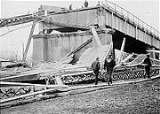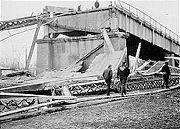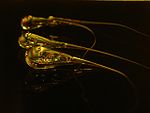
Residual stress
Encyclopedia
Residual stresses are stresses
that remain after the original cause of the stresses (external forces, heat gradient) has been removed. They remain along a cross section of the component, even without the external cause. Residual stresses occur for a variety of reasons, including inelastic deformations and heat treatment. Heat from welding
may cause localized expansion, which is taken up during welding by either the molten metal or the placement of parts being welded. When the finished weldment cools, some areas cool and contract more than others, leaving residual stresses. Another example occurs during semiconductor fabrication and microsystem fabrication when thin film
materials with different thermal and crystalline properties are deposited sequentially under different process conditions. The stress variation through a stack of thin film materials can be very complex and can vary between compressive and tensile stresses from layer to layer.
 Castings may also have large residual stresses due to uneven cooling. Residual stress is often a cause of premature failure of critical components, and was one factor in the collapse of the suspension bridge
Castings may also have large residual stresses due to uneven cooling. Residual stress is often a cause of premature failure of critical components, and was one factor in the collapse of the suspension bridge
at Silver Bridge
in West Virginia
, United States
in December 1967. The eyebar links were castings which showed high levels of residual stress, which in one Ibar, encouraged crack growth. When the crack reached a critical size, it grew catastrophically, and from that moment, the whole structure started to fail in a chain reaction. Because the structure failed in less than a minute, 46 drivers and passengers in cars on the bridge at the time were killed as the suspended roadway fell into the river below.
 While uncontrolled residual stresses are undesirable, some designs rely on them. For example, toughened glass
While uncontrolled residual stresses are undesirable, some designs rely on them. For example, toughened glass
and pre-stressed concrete depend on residual stress to prevent brittle
failure. A demonstration of the effect is shown by Prince Rupert's Drop
, where a molten glass globule is quenched to produce a toughened outer layer.
Bolted joints use residual stress to avoid subjecting bolts to fatigue
. A gradient in martensite
formation leaves residual stress in some swords with particularly hard edges (notably the katana
), which can prevent the opening of edge cracks.
In certain types of gun barrels made with two tubes forced together, the inner tube is compressed while the outer tube stretches, preventing cracks from opening in the rifling when the gun is fired. Parts are often heated or dropped into liquid nitrogen
to aid assembly.
s are another example where the stress created by penetration of wood then helps to keep the nail in place.
is an alternative non-destructive method which allows measurement of residual stress in isolated spots. The choice between these two techniques depends on the design of the mechanical part to be tested.
Stress (physics)
In continuum mechanics, stress is a measure of the internal forces acting within a deformable body. Quantitatively, it is a measure of the average force per unit area of a surface within the body on which internal forces act. These internal forces are a reaction to external forces applied on the body...
that remain after the original cause of the stresses (external forces, heat gradient) has been removed. They remain along a cross section of the component, even without the external cause. Residual stresses occur for a variety of reasons, including inelastic deformations and heat treatment. Heat from welding
Welding
Welding is a fabrication or sculptural process that joins materials, usually metals or thermoplastics, by causing coalescence. This is often done by melting the workpieces and adding a filler material to form a pool of molten material that cools to become a strong joint, with pressure sometimes...
may cause localized expansion, which is taken up during welding by either the molten metal or the placement of parts being welded. When the finished weldment cools, some areas cool and contract more than others, leaving residual stresses. Another example occurs during semiconductor fabrication and microsystem fabrication when thin film
Thin film
A thin film is a layer of material ranging from fractions of a nanometer to several micrometers in thickness. Electronic semiconductor devices and optical coatings are the main applications benefiting from thin film construction....
materials with different thermal and crystalline properties are deposited sequentially under different process conditions. The stress variation through a stack of thin film materials can be very complex and can vary between compressive and tensile stresses from layer to layer.
Premature failure

Suspension bridge
A suspension bridge is a type of bridge in which the deck is hung below suspension cables on vertical suspenders. Outside Tibet and Bhutan, where the first examples of this type of bridge were built in the 15th century, this type of bridge dates from the early 19th century...
at Silver Bridge
Silver Bridge
The Silver Bridge collapsed in 1967, killing 46 people. The terms Silver Bridge or Silverbridge may also refer to:* Silver Memorial Bridge, the replacement for the above bridge, opened in 1969....
in West Virginia
West Virginia
West Virginia is a state in the Appalachian and Southeastern regions of the United States, bordered by Virginia to the southeast, Kentucky to the southwest, Ohio to the northwest, Pennsylvania to the northeast and Maryland to the east...
, United States
United States
The United States of America is a federal constitutional republic comprising fifty states and a federal district...
in December 1967. The eyebar links were castings which showed high levels of residual stress, which in one Ibar, encouraged crack growth. When the crack reached a critical size, it grew catastrophically, and from that moment, the whole structure started to fail in a chain reaction. Because the structure failed in less than a minute, 46 drivers and passengers in cars on the bridge at the time were killed as the suspended roadway fell into the river below.
Controlled residual stress

Toughened glass
Toughened or tempered glass is a type of safety glass processed by controlled thermal or chemical treatments to increase its strength compared with normal glass. Tempering creates balanced internal stresses which cause the glass, when broken, to crumble into small granular chunks instead of...
and pre-stressed concrete depend on residual stress to prevent brittle
Brittle
A material is brittle if, when subjected to stress, it breaks without significant deformation . Brittle materials absorb relatively little energy prior to fracture, even those of high strength. Breaking is often accompanied by a snapping sound. Brittle materials include most ceramics and glasses ...
failure. A demonstration of the effect is shown by Prince Rupert's Drop
Prince Rupert's Drop
Prince Rupert's Drops are a glass curiosity created by dripping hot molten glass into cold water. The glass cools into a tadpole-shaped droplet with a long, thin tail. The water rapidly cools the molten glass on the outside of the drop, while the inner portion of the drop remains significantly...
, where a molten glass globule is quenched to produce a toughened outer layer.
Bolted joints use residual stress to avoid subjecting bolts to fatigue
Fatigue (material)
'In materials science, fatigue is the progressive and localized structural damage that occurs when a material is subjected to cyclic loading. The nominal maximum stress values are less than the ultimate tensile stress limit, and may be below the yield stress limit of the material.Fatigue occurs...
. A gradient in martensite
Martensite
Martensite, named after the German metallurgist Adolf Martens , most commonly refers to a very hard form of steel crystalline structure, but it can also refer to any crystal structure that is formed by displacive transformation. It includes a class of hard minerals occurring as lath- or...
formation leaves residual stress in some swords with particularly hard edges (notably the katana
Katana
A Japanese sword, or , is one of the traditional bladed weapons of Japan. There are several types of Japanese swords, according to size, field of application and method of manufacture.-Description:...
), which can prevent the opening of edge cracks.
In certain types of gun barrels made with two tubes forced together, the inner tube is compressed while the outer tube stretches, preventing cracks from opening in the rifling when the gun is fired. Parts are often heated or dropped into liquid nitrogen
Liquid nitrogen
Liquid nitrogen is nitrogen in a liquid state at a very low temperature. It is produced industrially by fractional distillation of liquid air. Liquid nitrogen is a colourless clear liquid with density of 0.807 g/mL at its boiling point and a dielectric constant of 1.4...
to aid assembly.
Press fits
Press fits are the most common intentional use of residual stress. Automotive wheel studs, for example are pressed into holes on the wheel hub. The holes are smaller than the studs, requiring force to drive the studs into place. The residual stresses fasten the parts together. NailNail (engineering)
In woodworking and construction, a nail is a pin-shaped, sharp object of hard metal or alloy used as a fastener. Formerly wrought iron, today's nails are typically made of steel, often dipped or coated to prevent corrosion in harsh conditions or improve adhesion...
s are another example where the stress created by penetration of wood then helps to keep the nail in place.
Measurement techniques
There are several techniques that are used to measure the residual stress. They can be classified as destructive and non-destructive methods. Mechanical methods or dissection uses the release of stress and its associated strain after doing a cut, hole or crack. Nonlinear elastic methods as ultrasonic or magnetic techniques requires a reference sample. X-ray diffraction is a non-destructive method which allows the measurement of residual stress in isolated spots spaced distances as small as 100 micrometres. Neutron diffractionNeutron diffraction
Neutron diffraction or elastic neutron scattering is the application of neutron scattering to the determination of the atomic and/or magnetic structure of a material: A sample to be examined is placed in a beam of thermal or cold neutrons to obtain a diffraction pattern that provides information of...
is an alternative non-destructive method which allows measurement of residual stress in isolated spots. The choice between these two techniques depends on the design of the mechanical part to be tested.
Further reading
- Cary, Howard B. and Scott C. Helzer (2005). Modern Welding Technology. Upper Saddle River, New JerseyNew JerseyNew Jersey is a state in the Northeastern and Middle Atlantic regions of the United States. , its population was 8,791,894. It is bordered on the north and east by the state of New York, on the southeast and south by the Atlantic Ocean, on the west by Pennsylvania and on the southwest by Delaware...
: Pearson Education. ISBN 0-13-113029-3.
External links
- - Energy-saving technology and computerized equipment for vibration stabilization of residual stress (the only CIS 35-year-old Scientific School, who presented in 1988, the world's first installation of computer diagnostics) are intended to stabilize the residual stresses in welds, castings and other non-rigid dynamic metal
- Residual stresses at The Welding Institute
- Comprehensive resources on Residual stresses at Cambridge University

